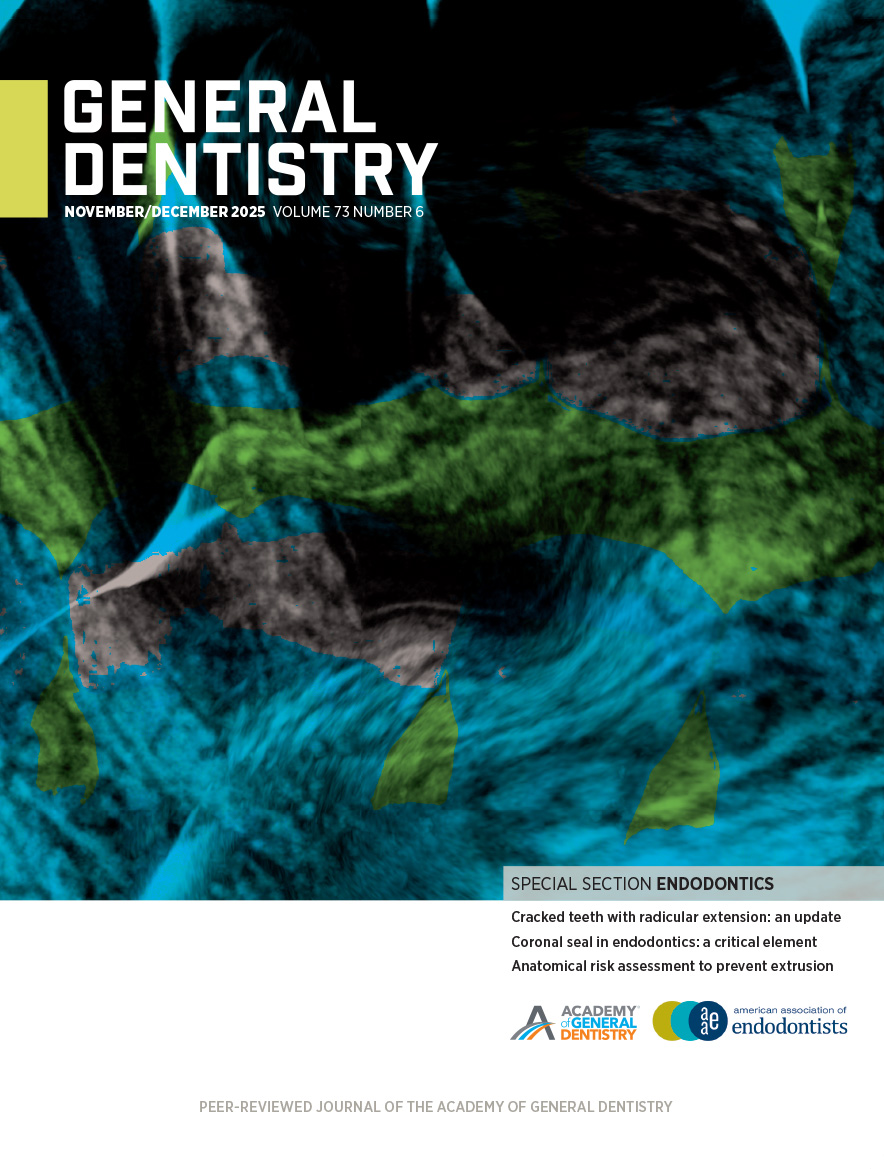
General Dentistry is the award-winning, peer-reviewed journal of the Academy of General Dentistry. Published bimonthly, General Dentistry features clinical articles spanning the breadth of topics relevant to general dentists, including unique diagnostic case reports, novel solutions to common treatment dilemmas, evidence-based best practices, and the science to help you choose the best materials, technology and procedures for your patients and your practice.
Table of Contents
Departments
-
Editorial Starting with the end in mind: collaborative care by general dentists and endodontists
Full Article (PDF)Bruce L. Cassis2025 November/December; 73(6):6.
-
AAE Guest Editorial Partners in preservation: the value of endodontics in general practice
Full Article (PDF)Steven J. Katz2025 November/December; 73(6):7
-
Oral Diagnosis Cigar-shaped radiopacity and Unusual root abnormality
Full Article (PDF)Galal Omami2025 November/December; 73(6):78,80.
-
Self-Instruction Answers Exercises No. GD536, GD537, and GD538
Full Article (PDF)2025 November/December; 73(6):79.
Clinical Articles
-
Endodontics | AAE Collaboration Beyond the apex: anatomical risk assessment to prevent extrusion injuries in endodontics
Full Article (PDF)Gordon S. LaiExtrusion of irrigants or obturation materials during endodontic therapy may result in significant complications, ranging from postoperative pain to nerve damage and chronic inflammation. This article explores how anatomical complexities, including root apex morphology, proximity to vital structures, and apical resorption, contribute to extrusion risk.2025 November/December; 73(6):8-13
-
Endodontics | AAE Collaboration Cracked teeth with radicular extension: an update on restorative procedures for endodontically treated deeply cracked teeth
Full Article (PDF)Matthew C. DavisSuhaila S. ShariffRecent evidence supports a conservative treatment approach for cracked teeth with radicular extension. This article outlines a protocol that emphasizes preserving pericervical dentin, sealing the crack internally to prevent bacterial contamination, and minimizing stresses. This protocol produces survival and success rates comparable to those of noncracked teeth, enabling preservation of natural dentition.2025 November/December; 73(6):14-21
-
Endodontics | AAE Collaboration Coronal seal in endodontics: a critical but forgotten element
Full Article (PDF)Anil KishenPrasanna NeelakantanThis review examines the microbiologic, clinical, and materials science evidence regarding the importance of a coronal seal in endodontic restorations. Published data indicate the importance of placing a permanent coronal seal as soon as possible following treatment. Moreover, a dual-seal approach, emphasizing the integrity of both apical and coronal sealing, is integral to treatment success.2025 November/December; 73(6):22-30
-
SELF-INSTRUCTION
Endodontics Failures and successes of vital pulp therapy in an undergraduate dental clinic
Full Article (PDF)John F. WisniewskiMitchell HogueThis study presents 2 treatment sequences for successful vital pulp therapy in mature permanent teeth and describes unsuccessful and successful application of the procedures. Two treatments failed because not all affected tissue was removed and inferior capping materials were used. Two successful cases included selective removal of affected pulp tissue and placement of calcium silicate cements.2025 November/December; 73(6):32-38
Self-Instruction Exercise No. GD552 -
SELF-INSTRUCTION
Endodontics Combined endodontic and periodontal management of trauma-induced tooth resorption: case reports and review of the literature
Full Article (PDF)Shubham TripathiPallav PatniPradeep JainSwadhin RaghuwanshiSanket Hans PandeyThis article reports 2 cases of invasive cervical resorption treated with root canal therapy, removal of granulation tissue, and placement of trichloroacetic acid and mineral trioxide aggregate. The approach was surgical in 1 case and nonsurgical in the other; in both cases, follow-ups showed good results and no recurrence. A literature review summarizes previously reported cases of invasive cervical resorption.2025 November/December; 73(6):41-49
Self-Instruction Exercise No. GD553 -
SELF-INSTRUCTION
Restorative Dentistry Effect of the endodontic sealer on the bond strength of glass fiber posts
Full Article (PDF)Rafael Coutinho SilvaMariana de Almeida BarbosaBruna MichelsJulia CarelliKatia Raquel WeberCarla Castiglia GonzagaFlavia Sens Fagundes TomazinhoThis study assessed the effect of the endodontic sealer (bioceramic or epoxy resin–based) on the bond strength between glass fiber posts and root dentin at different storage times (7 days or artificial aging), also considering the root canal region (cervical, middle, and apical). None of the evaluated variables had a significant effect on push-out bond strength.2025 November/December; 73(6):51-54.
Self-Instruction Exercise No. GD554 -
Restorative Dentistry Practical implementation of caries disease management in the era of CAMBRA: a guide for the general dentist
Full Article (PDF)Douglas A. YoungRyan L. QuockSusie GoolsbyMartha McComasSteven PowellGregory G. ZellerAllen WongBrian B. NovýThe philosophy of caries management by risk assessment (CAMBRA) is widely accepted as a valuable form of comprehensive disease management, but its implementation in clinical practice has been hindered by a lack of concise guidance to bridge the gap between research and the logistics of patient care. This review presents clinical strategies in a functional format, integrating evidence-based systems such as the American Dental Association Caries Classification System and caries risk assessment.2025 November/December; 73(6):56-66.
-
Basic Science Color stability of composite resins with different photoinitiator systems when subjected to water aging: an in vitro study
Full Article (PDF)Garima PoddarSuparna G. SahaRolly S. AgarwalManasi KewlaniAnu VashishtAjay S. RaoThe objective of this study was to evaluate the color stability of composite resins with different photoinitiator systems when subjected to water aging. A composite resin with a diphenyl (2,4,6-trimethylbenzoyl) phosphineoxide (TPO) initiator exhibited better color stability than Ivocerin- and camphorquinone-based resins, suggesting that TPO may offer enhanced long-term esthetic durability.2025 November/December; 73(6):67-70.
-
Prosthodontics Antimicrobial efficacy of a novel antimicrobial 3D-printed denture base resin
Full Article (PDF)Behailu B. EsheteaMaha LeilaTimothy ChoMaggie Xiaoxia LiuNeil ParkJason A. GriggsSreenivas KokaA denture base resin impregnated with an antimicrobial agent (silver sodium hydrogen zirconium phosphate) and designed for 3-dimensional (3D) printing was evaluated to test its antimicrobial activity against common oral pathogens. Compared with a commonly used 3D-printed resin without an antimicrobial agent, the antimicrobial resin had potent short-term and long-term antimicrobial effects.2025 November/December; 73(6):71-77.

